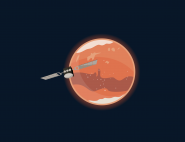CNES projects library
C
I
M
P
S
U
Bi
Mars Express
Launched on 2 June 2003, the Mars Express spacecraft entered orbit around Mars on 25 December of the same year and began its mission to map the Red Planet at a pixel resolution of 10 metres, sound its subsurface to search for pockets of water or ice, and finely analyse the composition of its atmosphere and ionosphere.
Over the next 10 years, the European probe gathered a wealth of precious information, detecting the presence of clay to confirm that liquid water once flowed on the surface of Mars, determining the nature and volume of water stored in its polar ice caps and undertaking a detailed analysis of the composition of Mars’ atmosphere and how it interacts with the solar wind.
Mars Express also obtained unprecedented pictures of Mars’ small moon Phobos on three separate flybys in July 2008, March 2010 and January 2011.
The spacecraft was also carrying a lander called Beagle 2 when it departed Earth. The small rover was released on 19 December 2003 but unfortunately contact was never established with it after that.
Of the three instruments on Mars Express, two were built under French prime contractorship. OMEGA, a visible and infrared mineralogical mapping spectrometer, is an imaging spectrometer conceived by the IAS space astrophysics institute in Orsay and the LESIA space and astrophysics instrumentation research laboratory in Meudon to study Mars’ surface mineralogy. SPICAM, an ultraviolet and infrared atmospheric spectrometer, is dedicated to analysing Mars’ atmosphere and was developed by the LATMOS atmospheres, environments and space observations laboratory in Paris-Guyancourt.
CNES has played a central role in developing and operating Mars Express, supplying technical support and funding for the development of OMEGA and SPICAM, and providing the ground segment for ASPERA, the third instrument on Mars Express to which France contributed. Developed under ESA’s Horizon 2000 science programme, the Mars Express mission has been extended to the end of 2022.
Mission's news feed
-

Better understanding of Earth’s atmospheric chemistry from studying Mars?
Long-term studies of ozone and water vapour in the atmosphere of Mars could lead to better understanding of atmospheric chemistry for the Earth. A new analysis of data from ESA...
July 23, 2021
-

Unique use of ESA spacecraft ‘housekeeping’ data reveals cosmic ray behaviour
Using data originally gathered for spacecraft ‘housekeeping’ aboard ESA’s Rosetta and Mars Express missions, scientists have revealed how intense bursts of high-energy radiation,...
June 28, 2021
-

Mars water loss shaped by seasons and storms
Mars has lost most of its once plentiful water, with small amounts remaining in the planet’s atmosphere. ESA’s Mars Express now reveals more about where this water has gone,...
March 22, 2021


